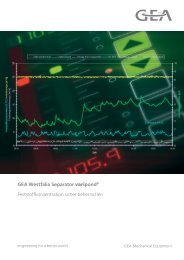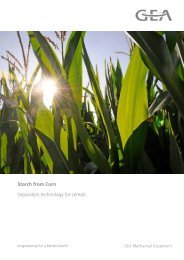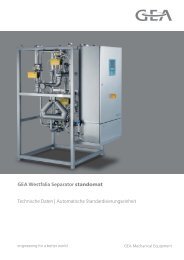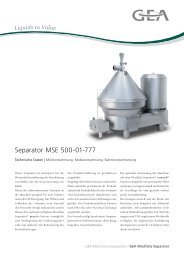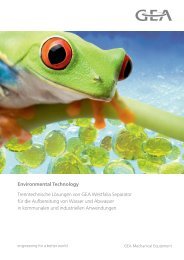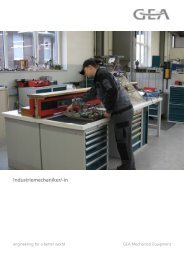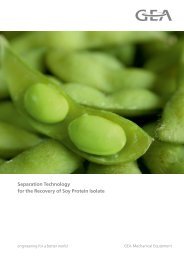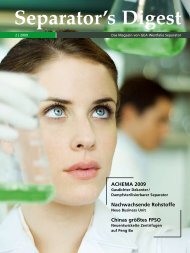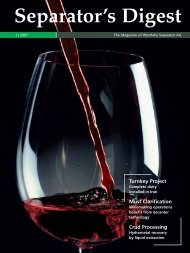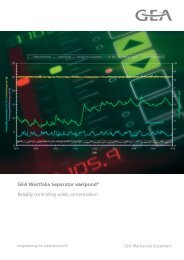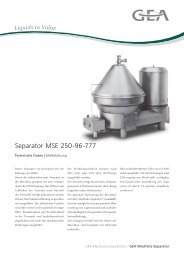Separator's Digest 2009/3 (Special Edition 100 Years beer separation)
Separator's Digest 2009/3 (Special Edition 100 Years beer separation)
Separator's Digest 2009/3 (Special Edition 100 Years beer separation)
Create successful ePaper yourself
Turn your PDF publications into a flip-book with our unique Google optimized e-Paper software.
All Good ThinGs CoMe in Threes:<br />
sepArATor, deCAnTer, MeMbrAne filTrATion<br />
Beer Recovery<br />
More and more breweries are investing in <strong>beer</strong><br />
recovery – for good reasons.<br />
This improves their cost-effectiveness without changing the <strong>beer</strong><br />
quality. Indeed, the yeast and tank bottom volume accounts for<br />
approx. four percent of total annual output, and of this figure<br />
approximately 60 percent can be recovered in the form of <strong>beer</strong>. At a<br />
brewery with an output of one million hectolitres, this corresponds<br />
to a volume of 24,000 hectolitres. Which of the three possible systems<br />
(separator, decanter and ceramic membrane filter) is used in<br />
a specific application depends on the particular circumstances of<br />
the brewery. However, it is certain that GEA Westfalia Separator is<br />
the only provider to make all three process alternatives; this means<br />
that it is able to provide neutral advice and make recommendations<br />
which are suitable for each specific operation.<br />
Easy process management with separators<br />
The separator represents the most simple process solution with<br />
minimum investment costs. With its continuous process, the process<br />
time is only 120 seconds; the yeast is accordingly exposed to very<br />
gentle treatment. On the other hand, production times are long:<br />
The separator is subject to standard CIP only every 72 hours. The<br />
GSC 150 separator, which is specifically suited to this task,<br />
ensures that the yeast is treated to a dry matter content of around<br />
25 percent thanks to the Westfalia Separator hydrostop discharge<br />
system. The hydrohermetic inlet ensures gentle treatment of the<br />
product. Depending on throughput, the recovered <strong>beer</strong> still contains<br />
around 0.1 to 2 million cells per millilitre. The hydrohermetic seal<br />
also prevents the product from coming into contact with external<br />
air, and guarantees absolutely wear-free operation.<br />
With the GSC 150 separator, it is possible for <strong>beer</strong> to be recovered<br />
from yeast and also for the green <strong>beer</strong> from the fermentation tank<br />
to be clarified following the addition of yeast upstream of<br />
the separator. In the feed, the yeast concentration may be max.<br />
40 percent (by volume).<br />
Decanter technology for larger breweries<br />
For larger breweries in excess of approx. two million hectolitres <strong>beer</strong><br />
output, decanter technology is the most cost-effective solution. In<br />
the same way as the separator, the CB 506 fully hydrohermetic<br />
decanter developed specifically for <strong>beer</strong> recovery operates<br />
continuously, and can also adapt fully automatically to changing<br />
34<br />
Separator’s <strong>Digest</strong> Sonderausgabe <strong>2009</strong><br />
GEA Westfalia Separator Process



